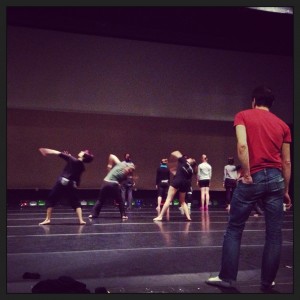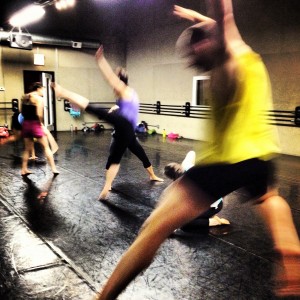
by Katie Sopoci Drake
Oh! What to do when you’ve been hired to set a piece on a company, school, department, etc. and when you show up, BAM! It hits you like a ton of bricks. You realize, “These dancers are going to F. A. I. L. if I proceed as planned with my choreography.” Whatever the reason (too little technique, the wrong technique, stubborn, etc.) you cannot allow this to happen because it is your job as choreographer to…
- Make your dancers look good. Which will, in turn…
- Make your choreography look good. Which will ensure that you…
- Make your self look good by making the whole process a success. Because you want to be called again to set more work. Perhaps this time for a piece that is more appropriate for the dancers.
It’s a sticky situation that is mostly avoided by directors doing their homework about a choreographer and choreographers doing their homework about companies/schools/etc. But let’s be real; sometimes directors just need someone to fill the spot and sometimes you just need to get a choreography gig. I know all of this too well because, baby, sometimes Momma just needs a new pair of shoes… or to pay the utility bill. How do we turn this around? Here are a couple of lessons I’ve learned from all sorts of gooey, hot, messes:
It’s time to Pivot when: the dancers are trained in a completely different technique from yours and there is no time to teach them enough of the one you’re using in your piece. Yes, “Pivot” is horrible business jargon, but it’s also a fabulous dance move that we all can relate to. To pivot is to efficiently turn in a new direction, which is what you’re going to have to do, and quick, if you’re going to finish the dance in the limited number of rehearsals given. Think, “Is there a way to use their technique to accomplish my dance?”, “Is there another piece in my repertory that might suit them better?”, or, “Is there a more suitable piece in my repertory that I can pull material from to patch rough spots in this one?”. You’ll have to have a conversation with the director about what you’re seeing in the studio and how to proceed.
Going back to the origin of the movement is essential if you decide to forge ahead with the current piece. You’re going to need to adapt it to the dancers in front of you and reacquainting yourself with the roots of your dance is going to help you do it. If your piece has long lines, but the dancers do not, think about why you put those long lines there in the first place. Was it an architectural choice? Was it an emotional choice? Was it about the strengths of the original dancers? Work from the origins of the movement to find an adaptation that will be successful on the dancers you have in front of you.
When I recently reset a piece on a new dancer, I went back to the root of why the phrase/gesture/movement showed up in the first place. One of the repeating motifs was a twisted and tilted arabesque that elongated to create tension, but I knew that wouldn’t work for this soloist. I told the dancer that I needed something that stretched from two ends until it about snapped. Then I sat back and watched her work it out on her body until the new movement jumped out at me within a minute. I said, “that’s it!” and we were free to move on to the next puzzle. No muss, no fuss. Dancers are quick thinkers when you give them freedom to work it out on their own bodies. The part looks completely different now, but as long as the dancer is accomplishing the goal of the movement, that is a sign of success in my book.
Get Help! If the current piece is unsalvageable, you have the time to build something new, but are hitting a wall with the dancers, then in the words of Doris Humphrey, “Listen to qualified advice; don’t be arrogant.” Pull in the director and peers to look at the stages of the dance. Work that hasn’t had time to be performance-tested needs another eye and the dancers are often more willing to try something new if they know the director is involved in the process.
Lastly, Work with what you’re given. Trust in your own ability to create a compelling structure, and only build phrases with material that looks strong on the dancers. Whether you’re someone who has the dancers create the phrases, or if you create each phrase and feed it to the dancers, trust your instincts. You will see what is working and what is not. Be honest with yourself and cut out what is not being accomplished to your highest standards and, above all, “kill your darlings”. Just because you loved it in your previous pieces doesn’t mean it works this time. In the end, this usually means that you are working with less material, but there are plenty of masterworks in every genre that are startling arrangements of simple movements. Repetition will be your friend here.
Now, get out there and make those dancers look fabulous!

Contributor Katie C. Sopoci Drake, MFA, GL-CMA, is a Washington D.C. based professional dancer, choreographer and teacher specializing in Laban-based contemporary dance. Holding an MFA in Dance from the University of Wisconsin-Milwaukee, a Graduate Certification in Laban Movement Analysis from Columbia College – Chicago, and a BA in Theatre/Dance with a minor in Vocal Performance from Luther College, Sopoci Drake continues to take classes in as many techniques and practices as she can handle to inform her work and life as a curious mover.

Photo by Scott Pakudaitis
Katie has been on faculty at The University of Wisconsin-Milwaukee, Nova Southeastern University, Miami Dade College-Wolfson, Miami Dade College-Kendall, Carthage College, and Lawrence University. She currently guest teaches and gives masterclasses around the D.C. area and wherever her travels take her.
As a performer, Sopoci is described as a “sinuous, animal presence of great power; watching her dance is a visceral experience.” (Third Coast Digest). Company credits include Mordine and Company Dance Theater of Chicago, Momentum Dance Company of Miami, Wild Space Dance Company of Milwaukee, and Rosy Simas Danse of Minneapolis. Katie has also made appearances an an independent artist with many companies including Brazz Dance, Your Mother Dances, The Florentine Opera, and The Minnesota Opera.
Katie’s choreography, described as “a beautiful marriage between choreography, music and poetry” (On Milwaukee), arises from her fascination with the idiosyncrasies of daily life, and the flights of fancy that arise from ordinary inspirations. Her work has been performed by numerous companies, colleges and studios across the country and her latest collaboration, Telephone Dance Project, will take her to states up and down the East Coast while investigating long-distance creation and connecting far-flung dance communities.





Terrific piece Katie. Really dives into this (all too common) experience with wisdom and humor. I hope I get to see your choreography – and you – in the not so distant future!
Thanks, Nina! I hope we cross paths again soon!
This blog is very insightful to choreographing in all aspects. It is important to be sensitive to how your dancers will display your work. Your quote, “Trust in your own ability to create a compelling structure, and only build phrases with material that looks strong on the dancers,” hit the nail straight on, as many artists want to create what they have i their mind and what they themselves are capable of performing. I recently wrote a post on my blog, “Dance Instructor” (Be Innovative) that states, “use the students’ abilities to get the attention, not only of their audience, but the students’ to their instructor. If one student can do multiple pirouettes, or a big jump well, place a solo for that student within your choreography.” Choreography can definitely be difficult if we remain in ignorance.